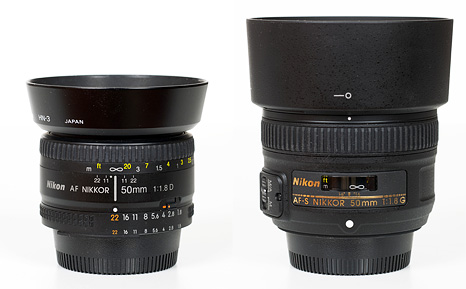|
Page 1 of 3

Review by Markus Stamm, published May 2011
Introduction
If there had been a competition for "Most unlikely new lens", this might have been the winner: the Nikkor AF-S 50mm f/1.8 G, an updated version of Nikon's entry level normal prime. Until accidently leaked on a Nikon web site, hardly anyone would have expected the long lasting AF-D 50/1.8 to see an update soon. There are many other primes in Nikon's current line up that certainly many consider to have higher priority to be refreshed.
For Nikon, the AF-S 50/1.8 G makes perfect sense, however. Due to their rather low cost, normal lenses are often purchased by many as their first prime and thus sell in rather high volumes (for a prime lens). In addition, especially 50mm lenses are very popular for portraiture on DX cameras, or any other application that benefits from shallow depth of field. Due to the omission of an integrated motor, the AF-D 50/1.8 lacked AF when used with current entry-level Nikon DSLRs, making the lens an unattractive option for a quite large market segment. The 50/1.8 G solves this issue with its AF-S drive.
In this review however we will have a look at the lens' performance in its native scope, as a full frame normal prime. As usual, we'll use the Nikon D3x as test camera for this FX review.

The build quality of the lens is very decent thanks to an outer barrel being made out of high quality plastics. The rubberized focus ring is slightly damped and operates reasonably smooth.
Unfortunately the focus ring shows a behaviour that we have seen in other recent Nikon lenses, too: there's a little play, not in the focus ring itself, but the coupling with the actual focus unit. When changing the focus direction, it takes a few millimeters of movement until the focus unit actually follows the focus ring. This can be annoying when trying to nail critical focus, for example in Live View.
The physical length of the lens remains constant at all focus settings. It's not a true IF (internal focus) design though - the inner tube moves within the outer barrel (linear extension focusing system).
A protective pouch as well as a dedicated hood with bayonet mount are included with the lens. However, the front lens is deeply recessed except for close focus distances and already well protected without a hood.
The front element does not rotate, so using a polarizer remains easily possible.

As an AF-S lens the Nikkor is compatible with all current Nikon DSLRs (including the motorless entry-level cameras) and features the usual advantages of a silent wave (ultrasonic) drive: there's manual override at any time in single-shot AF mode and AF action is very silent. However, just as with the AF-S 50/1.4G, the AF speed is not overly fast, the older screw-driven AF-D lens feels faster, at least on the cameras we have available (D7000 and D3x). It's quick enough for everyday use and most subjects, though.

Compared to its predecessor, the lens has become quite a bit larger. The increase in weight is moderate, though.
Optically the lens has been redesigned and features an aspherical element, which is quite unusual for such a lens.
The AF-S 50 is a G-type lens and thus does not offer an aperture ring.
| Specifications |
|---|
| Optical construction | 7 elements in 6 groups, incl. 1 aspherical element |
| Number of aperture blades | 7 (rounded) |
| min. focus distance | 0.45 m (max. magnification ratio 1:6.7) |
| Dimensions | 72 x 52.5 mm |
| Weight | 185 g |
| Filter size | 58 mm (non-rotating) |
| Hood | Nikon HB-47, barrel-shaped, bayonet mount (supplied) |
| Other features | Lens provides distance (D) information to the camera, Silent Wave AF motor |
|